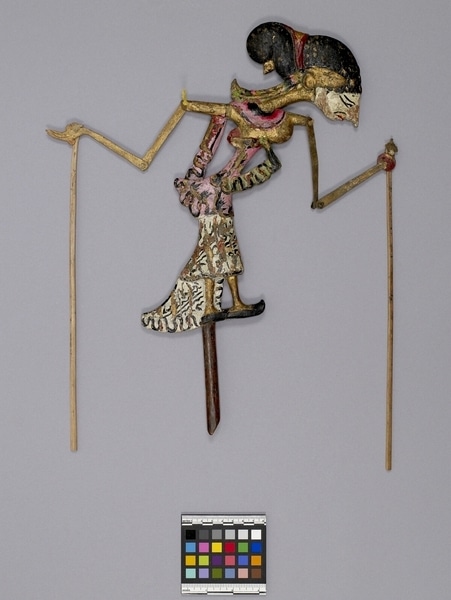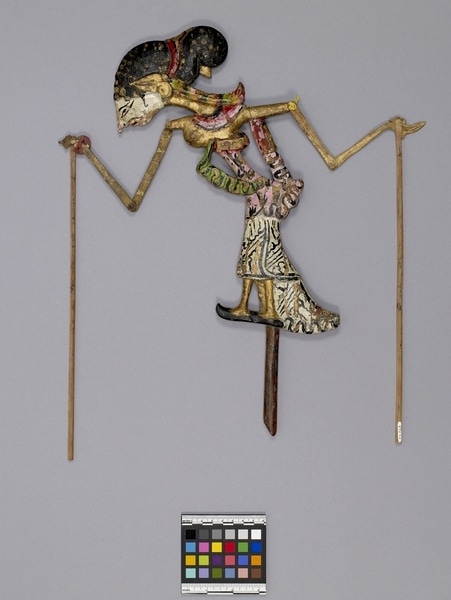Shadow Puppet Item Number: Ib268 from the MOA: University of British Columbia


Description
Puppet depicting a male human figure. Downturned white face with black moustache and eyes. Ketu, black with red band. Sumping. Black hair with a red tie. White ruffled skirt, ruffles outlined with black. Legs, arms, torso, and neck gold, pink, black, green, and red. Feet close together with black shoes. Movable arms, each with a control rod attached. Gelang on one lower arm. Handle extends down from feet.
History Of Use
Javanese puppetry as an art form probably evolved by the 11th century. Originally the plays depicted Javanese mythology, but after the Indian conquest of Java the Hindu epics, Ramayana and Mahabharata, were incorporated into the play cycles. The arrival of Islam in the 1500's introduced Muslim philosophy which can be found in some plays. There are four traditional play cycles: an animistic cycle of legends; the Ardjuna Sasru Bau cycle; the Rama cycle; and the Pandawa cycle. These comprise about 200 plays. There have been numerous topical plays but the traditional ones are most often performed. An individual or group hires a dalang (puppet-master) to celebrate important occasions. The performances are presented in three acts with instrumental and vocal accompaniment. The individual plays vary widely in detail but usually involve conflict between noble heroes and their evil counterparts and demons. The plays serve a moral as well as religious purpose. Each puppet's character is represented by its appearance and placement onstage: protagonists, with strong elements of good are placed to the right, antagonists of violent or unharmonious spiritual disposition to the left. The flat leather wayang kulit puppets preceded the wayang golek form, but many symbolic elements remain the same.
Cultural Context
Theatrical performance.
Iconographic Meaning
Ketu without Garuda, gelang on lower arm, and scarf all indicate a patih, a political minister or advisor. Body posture, hand gesture, attitude of head and eyes, colour of face, and rich clothing indicate an alus (noble or refined) character. Likely used in a secondary or supporting role.
Item History
- Made in Java, Indonesia
- Owned by Tradewind Antiques before March 15, 1983
- Received from Museum of Anthropology Shop Volunteers (Funding source) and Tradewind Antiques (Seller) on March 15, 1983
What
Who
- Culture
- Javanese
- Previous Owner
- Tradewind Antiques
- Received from
- Museum of Anthropology Shop Volunteers (Funding source) and Tradewind Antiques (Seller)
Where
- Holding Institution
- MOA: University of British Columbia
- Made in
- Java, Indonesia
When
- Ownership Date
- before March 15, 1983
- Acquisition Date
- on March 15, 1983
Other
- Condition
- poor
- Accession Number
- 0886/0002